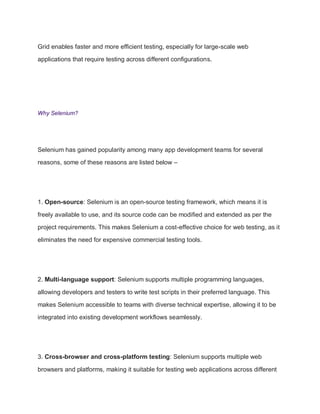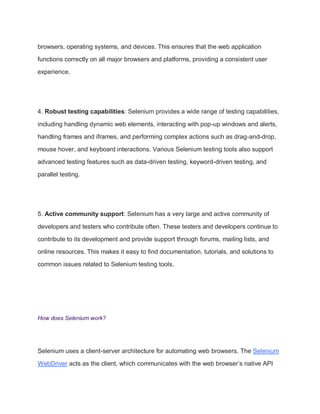Selenium Testing: A Comprehensive Guide to Automated Web Testing
- 1. Selenium Testing: A Comprehensive Guide to Automated Web Testing With the increasing complexity and dynamism of web applications, it has become crucial for app development teams to adopt robust testing techniques to ensure the quality of their web applications. One popular tool in the field of web testing is Selenium, an open-source automated testing framework that provides a wide range of features for automating web browsers. In this blog post, we will delve into the world of Selenium testing, exploring what it is, how it works, and why it has become the preferred choice for web testing among many app development teams. What is Selenium? Selenium is a popular and most flexible open-source testing framework that allows developers and testers to automate web browsers’ actions, such as clicking buttons, filling out forms, navigating between pages, and verifying page content. Selenium
- 2. supports multiple programming languages, including Java, C#, Python, Ruby, and JavaScript, making it a versatile choice for automating web testing across different technologies and platforms. The testing framework is composed of multiple Selenium Testing Tools, including Selenium IDE, Selenium WebDriver, and Selenium Grid. 1. Selenium IDE: Selenium IDE is a record-and-playback tool that allows testers to record their interactions with a web application and then replay them later to automate the testing process. Selenium IDE provides a simple and intuitive interface for creating, editing, and executing test scripts, making it ideal for beginners or for quick and easy test creation. 2. Selenium WebDriver: Selenium WebDriver is a most widely used component of Selenium testing tools and provides a programming interface for interacting with web browsers. Selenium WebDriver allows testers to write test scripts in their preferred programming language, providing more flexibility and control over the testing process. Selenium WebDriver supports various web browsers, including Chrome, Firefox, Safari, Edge, and Internet Explorer. 3. Selenium Grid: Selenium Grid is a distributed testing solution that allows testers to run tests in parallel across multiple browsers, operating systems, and devices. Selenium
- 3. Grid enables faster and more efficient testing, especially for large-scale web applications that require testing across different configurations. Why Selenium? Selenium has gained popularity among many app development teams for several reasons, some of these reasons are listed below – 1. Open-source: Selenium is an open-source testing framework, which means it is freely available to use, and its source code can be modified and extended as per the project requirements. This makes Selenium a cost-effective choice for web testing, as it eliminates the need for expensive commercial testing tools. 2. Multi-language support: Selenium supports multiple programming languages, allowing developers and testers to write test scripts in their preferred language. This makes Selenium accessible to teams with diverse technical expertise, allowing it to be integrated into existing development workflows seamlessly. 3. Cross-browser and cross-platform testing: Selenium supports multiple web browsers and platforms, making it suitable for testing web applications across different
- 4. browsers, operating systems, and devices. This ensures that the web application functions correctly on all major browsers and platforms, providing a consistent user experience. 4. Robust testing capabilities: Selenium provides a wide range of testing capabilities, including handling dynamic web elements, interacting with pop-up windows and alerts, handling frames and iframes, and performing complex actions such as drag-and-drop, mouse hover, and keyboard interactions. Various Selenium testing tools also support advanced testing features such as data-driven testing, keyword-driven testing, and parallel testing. 5. Active community support: Selenium has a very large and active community of developers and testers who contribute often. These testers and developers continue to contribute to its development and provide support through forums, mailing lists, and online resources. This makes it easy to find documentation, tutorials, and solutions to common issues related to Selenium testing tools. How does Selenium work? Selenium uses a client-server architecture for automating web browsers. The Selenium WebDriver acts as the client, which communicates with the web browser’s native API
- 5. through a driver specific to each web browser. The WebDriver sends commands to the web browser to perform various actions, such as clicking buttons, filling out forms, and navigating between pages, and then receives the responses from the browser, such as the page source or the element attributes, to verify the expected results. Steps to automate web testing using Selenium: 1. Identify elements: Selenium uses various techniques to locate web elements on a web page, such as by ID, name, class name, CSS selector, XPath, or link text. Testers can use these locators to identify and interact with the desired elements on the web page. 2. Interact with elements: Once the elements are identified, Selenium provides methods to interact with them, such as clicking buttons, filling out forms, selecting options from dropdowns, and performing other actions like mouse hover or keyboard interactions. These actions can be performed sequentially or in combination to simulate user interactions with the web application. 3. Verify results: After performing actions on the web elements, testers can use Selenium to verify the expected results. Selenium provides methods to extract information from web elements, such as text, attributes, and other properties, and compare them with expected values to ensure the correct behavior of the web application.
- 6. 4. Handle alerts, frames, and windows: Selenium also provides methods to handle alerts, frames, and windows that may appear during the testing process. Testers can switch between frames, accept or dismiss alerts, and switch to different windows to interact with different parts of the web application. 5. Write test scripts: Testers to write test scripts in their preferred programming language, using the WebDriver API. Test scripts can then be organized into test suites and can include assertions, conditional statements, loops, and other programming constructs to create robust reusable tests. 6. Finally execute the tests: Selenium tests can be executed locally on a single machine or distributed across multiple machines using Selenium Grid for parallel testing. Testers can also integrate Selenium tests into continuous integration (CI) and continuous delivery (CD) pipelines to automate the testing process as part of the development workflow. Best Practices for Selenium Testing:
- 7. 1. Use proper element locators: Choosing the right locators to identify web elements is critical for reliable and maintainable tests. It’s recommended to use unique and stable locators, such as IDs or CSS classes, and avoid using fragile locators that may change frequently, such as XPath that depends on the page structure. 2. Use wait and synchronization techniques: Web pages can load at different speeds, and elements may not be immediately available for interaction. Using wait and synchronization techniques, such as implicit waits, explicit waits, and expected conditions, ensures that tests wait for elements to be visible and interactive before interacting with them, improving the reliability of tests. 3. Keep tests modular and reusable: Writing modular and reusable tests helps in maintaining a clean and organized test suite. Tests should be independent of each other and not rely on the order of execution. Using Page Object Model (POM) or other design patterns can help in creating maintainable and scalable tests. 4. Implement error handling and reporting: Proper error handling and reporting mechanisms should be implemented in tests to capture and report failures effectively. Logging errors, taking screenshots, and reporting test results can help in identifying and fixing issues quickly.
- 8. 5. Regularly update and maintain tests: Web applications can change over time, and tests may become obsolete. It’s important to regularly update and maintain tests to ensure they continue to test the intended functionality. Tests should be reviewed, refactored, and updated as needed to keep them reliable and effective. Conclusion Selenium is a powerful and versatile tool for web testing that offers a wide range of features and capabilities. By utilizing Selenium effectively and following best practices, testers can create reliable and maintainable test suites that can help ensure the quality and reliability of web applications. With its extensive documentation, active community support, and widespread adoption in the industry, Selenium remains a top choice for web testing automation. So, if you’re an app testing professional looking for an efficient and effective way to automate your web testing, give Selenium a try and experience the benefits it has to offer. Happy testing!








